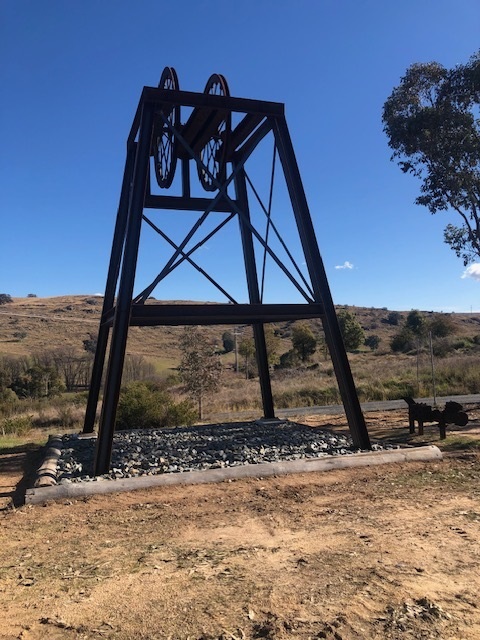Replica Mine Head added to Adelong Falls
Published on 07 August 2024

The heritage-listed Adelong Falls Gold Mill Ruins Outdoor Mining Museum now features a replica of a mine head to complement a range of other historic gold mining ruins on display along the Adelong Creek and Adelong Falls reserve.
Made possible with a grant from the NSW Heritage Community Grants program, with an additional $15,000 in funding and support from Snowy Valleys Council the mine head is now one of two significant industrial sculptures honouring Adelong’s gold mining history.
The mine head or poppet head as it is referred to, constructed in steel at an impressive 6 metres high, sits at the entrance to the Adelong Falls reserve and “bookends” the Adelong Falls walk that commences in the village car park where the replica full size stamper donated and built by Geoff Moss of Adelong Engineering is located.
A generous donation by Adelong landowner Mr. Bob Hughes(dec), of two impressive windlass or winding wheels provided the impetus and opportunity to construct the poppet head.
Historically a poppet head structure was built over the top of a shaft as a support for the wheels, allowing miners to access the mine below and retrieve the gold-bearing ore.
Mr Hughes had a keen interest in the area's gold mining history, also donating a de-watering pump, which is now on display at the site too. Mr Hughes’ father worked in mines in Kiandra as well as at the Gibraltar complex, which was downstream from the Adelong Falls. The donated winding wheels were last used at one of the mine heads at the Gibralter complex.
The poppet head design was crafted by Craig Anderson of Shutte & Kennard Engineers, Wagga Wagga, and constructed by Scandinavian Forestry & Engineering, Tumut. Both firms have been significant contributors to the Adelong Falls Reserve infrastructure in recent years.
Reef gold was first discovered in 1857 on Mount Charcoal overlooking the Adelong Township and Adelong’s main street is classified by the National Heritage Trust of Australia (NSW) with some buildings dating back to the gold rush.
Significant and extensive dredging and hydrosluicing of alluvial gold was undertaken between Grahamstown and Shepherdstown on the Adelong Creek below the Adelong Falls.
Gold production between 1857 and 1916 realised, from available records, about 25 tons. It is estimated that an additional 50% more gold was won from the Adelong Gold Field but was unrecorded.
Adelong’s population during the boom times was around 5,000, with many prospectors coming and going in search of the elusive ore.
Congratulations to the Adelong Falls Committee and the Adelong Alive museum for their continued dedication to developing the Adelong Falls Gold Mill Ruins Outdoor Mining Museum.